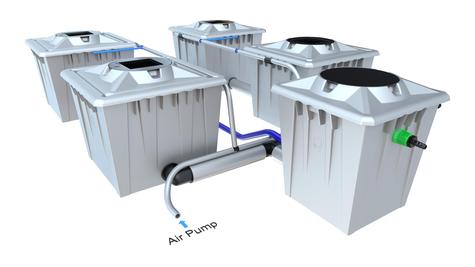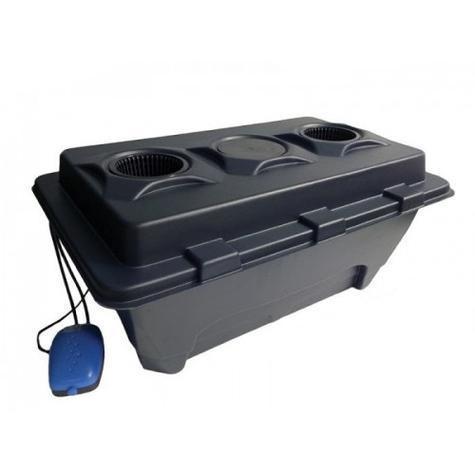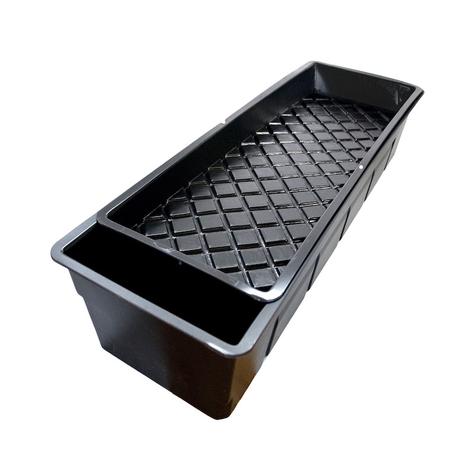
Hydroponics encompasses a variety of systems for growing plants without soil, each offering its own unique benefits and challenges.
This article explores two common methods: Deep Water Culture (DWC) and Nutrient Film Technique (NFT). It outlines how both systems function, identifies the advantages and disadvantages of each, and highlights the major differences and similarities between them.
Furthermore, the article offers guidance on selecting the right system to meet your gardening needs.
Deep Water Culture (DWC) and Nutrient Film Technique (NFT) are two innovative hydroponic systems widely utilised for efficient indoor gardening and commercial farming. Both methods aim to enhance plant health and optimise crop yield by providing plant roots with direct access to a nutrient-rich solution. DWC involves suspending the roots of plants in a nutrient solution, whereas NFT allows a thin film of nutrient solution to flow over the roots. Understanding the unique features, advantages, and disadvantages of these systems is essential for farmers and urban gardeners striving for sustainable local food production.
Both DWC and NFT systems showcase distinct designs that cater to various plant requirements and growing environments. DWC typically features a reservoir filled with oxygenated nutrient solution to promote healthy root development, while NFT relies on a sloped channel for optimal drainage and nutrient delivery. Key factors such as water quality, pH balance, and nutrient concentration significantly influence the success of these systems, directly affecting crop health and growth rates.
By implementing DWC and NFT, urban agriculturalists can maximise their space and resources, thereby contributing to food security in densely populated areas. This innovative approach encourages sustainable practices, making urban farming an essential component of modern agriculture.
Deep Water Culture (DWC) is a hydroponic system that allows plants to receive optimal oxygenation and nutrient delivery by immersing their roots in an oxygen-rich nutrient solution. This method is one of the most popular hydroponic systems and is highly favoured for its simplicity and efficiency, making it suitable for both novice gardeners and experienced growers. 
DWC systems can vary in design, but they generally require a reservoir to hold and warm the nutrient solution, a pump system for circulation, and components to monitor pH and oxygenation levels.
The Deep Water Culture (DWC) system is characterised by the direct suspension of plant roots in a nutrient solution, enabling plants in this growth medium to achieve rapid growth rates and well-developed root systems. The nutrient solution is specifically formulated to contain all the essential elements required for healthy plant growth. Additionally, the solution is aerated to provide the necessary oxygen for respiration, allowing the system to efficiently deliver both nutrients and air to promote vigorous plant development.
The relationship between the composition of the nutrient solution and root health is significant; as roots absorb nutrients, they grow and develop more effectively, which in turn enhances their ability to take up water and minerals. Aeration, achieved through the use of air stones and pumps, is a common feature in hydroponic systems that infuses oxygen into the water, creating an environment where beneficial microorganisms can thrive alongside the plants. This aeration helps maintain a baseline level of dissolved oxygen and prevents issues such as root rot that may arise from stagnant water.
While the complexity of the DWC system may slow growth rates, it ultimately contributes to the overall health and vitality of the system. 
Deep Water Culture (DWC) offers several advantages, including high crop yields, efficient water use, and minimal space requirements. However, it also has some disadvantages, such as the need for regular system maintenance and potential energy consumption issues.
The simplicity of DWC makes it accessible to a wide range of growers, facilitating effective nutrient uptake and rapid growth cycles. When considering DWC, it is important to weigh its advantages and disadvantages for well-considered choices in hydroponic farming.
DWC systems can significantly improve sustainability by using less water than traditional soil methods; however, some users may find the need for close monitoring of nutrient levels and pH for effective crop management to be a drawback. Energy consumption can also be a concern due to the reliance on pumps and air stones for oxygenating the water, particularly for larger-scale operations.
Despite these challenges, many growers appreciate DWC's simplicity, which enables them to achieve healthy plants and high yields with relative ease. This makes it an ideal strategy for both novice and experienced growers who aim to maximise production sustainably.
The Nutrient Film Technique (NFT) is an advanced hydroponic system that delivers nutrients directly to plant roots through a thin film of nutrient solution. Unlike Deep Water Culture (DWC), NFT relies on a continuous flow of nutrient solution, which enhances scalability and system reliability.
This method is renowned for its space efficiency and improved nutrient uptake, making it suitable for a variety of crops. 
The Nutrient Film Technique (NFT) is a hydroponic system in which a thin stream of nutrient solution continuously flows over the roots of plants. This method provides optimal nutrient delivery and supports rapid growth cycles. The NFT system recycles the nutrient solution, minimising water usage while creating an ideal environment for plant roots to thrive without being fully submerged.
Plus promoting plant health, NFT enhances growth rates by allowing plants to absorb nutrients quickly and easily. The constant flow of the nutrient solution also promotes aeration around the roots, ensuring a balanced supply of essential nutrients and facilitating oxygen exchange. By integrating water and nutrients, waste is minimised, making NFT an environmentally friendly choice for modern agriculture.
Furthermore, the ability to control nutrient delivery shortens growth cycles and helps achieve peak plant performance, resulting in higher yields.
The Nutrient Film Technique (NFT) offers several advantages, such as high efficiency and favourable crop yields, but it also presents certain challenges, including system complexity and maintenance requirements that demand careful management.
One of the significant benefits of NFT is its reduced water usage and enhanced nutrient retention, making it a sustainable option for hydroponic growers.
However, the technique also poses risks, such as the potential for root drying and system failures, which necessitate a thorough understanding of operational requirements. NFT systems often require continuous monitoring and troubleshooting, which can be daunting for some growers, particularly those who are new to hydroponics.
Furthermore, the energy costs associated with powering pumps and lights in NFT systems can contribute to higher overall operational expenses, raising questions about market viability in a competitive landscape.
Striking the right balance between the advantages of optimal resource usage and the disadvantages inherent in NFT systems is crucial for growers.
A comparison of Deep Water Culture (DWC) and Nutrient Film Technique (NFT) highlights their differences and similarities in system setup, efficiency, and suitable crop types.
Both systems are hydroponic, meaning they provide nutrients to plants without the use of soil. They require precise monitoring and management of nutrient levels and water quality to ensure optimal plant growth. Additionally, both systems facilitate year-round cultivation and can be utilised indoors or outdoors.
Understanding the differences and similarities between DWC and NFT systems enables growers to select the most suitable method for their specific conditions, including crop selection, available space, and resource management.
The key differences between Deep Water Culture (DWC) and Nutrient Film Technique (NFT) lie in their basic structures and their effects on water conservation and growth rates. DWC allows roots to be submerged in a nutrient solution, while NFT maintains a continuous film of nutrient solution flowing over the roots. Both systems are designed to optimise plant health and enhance crop yields.
In a DWC system, the roots are immersed in a deep reservoir of nutrient-rich solution, ensuring that they always have access to the necessary water and nutrients. This results in faster growth rates, making it ideal for individuals seeking larger plants or cultivating high-demand crops.
Conversely, NFT utilises a sloped channel where a thin layer of nutrient solution flows over the roots. This method allows NFT systems to conserve significantly more water than DWC systems, as they operate in a closed-loop system. However, because of the reduced water volume, the nutrient solution can become imbalanced more easily. Additionally, since the roots are exposed, they can dry out quickly if the flow of the nutrient solution is interrupted.
Both systems require proper aeration; DWC systems use air stones for oxygenation, while NFT systems depend on the oxygen that roots receive from exposure to the air. Ultimately, both systems are designed to enhance root access to the nutrients they need.
Selecting the right hydroponic system for your needs depends on several factors, including your crop management goals, available garden space, and budget constraints, particularly start-up costs.
Deep Water Culture (DWC) and Nutrient Film Technique (NFT) both provide unique advantages that make them better suited for different growing environments and personal preferences. Understanding the specific requirements of your plants, along with the characteristics of each system, will significantly enhance your chances of success in hydroponic farming.
When evaluating hydroponic systems, several important factors must be considered, including the types of crops to be grown, the growth environment that will be provided, and the maintenance required to ensure sustainable practices.
Understanding the different characteristics of hydroponic systems, such as the distinctions between Deep Water Culture (DWC) and Nutrient Film Technique (NFT), can enhance plant health and crop yield whilst also promoting resource conservation and sustainable practices.
The choice of crops is crucial, as not all hydroponic systems are suitable for every type of plant; for example, leafy greens thrive in certain systems, whereas fruiting plants may require additional support and nutrients.
Additionally, the growth environment's light levels, humidity, and temperature significantly influence plant growth and disease management. The importance of sustainability in modern agriculture cannot be overstated.
Implementing techniques that promote ecosystem balance, such as integrated pest management and water recycling, can help reduce the carbon footprint and enhance productivity.
Therefore, these factors must be carefully considered when selecting a hydroponic system and its methodology to ensure maximum productivity with minimal environmental impact.